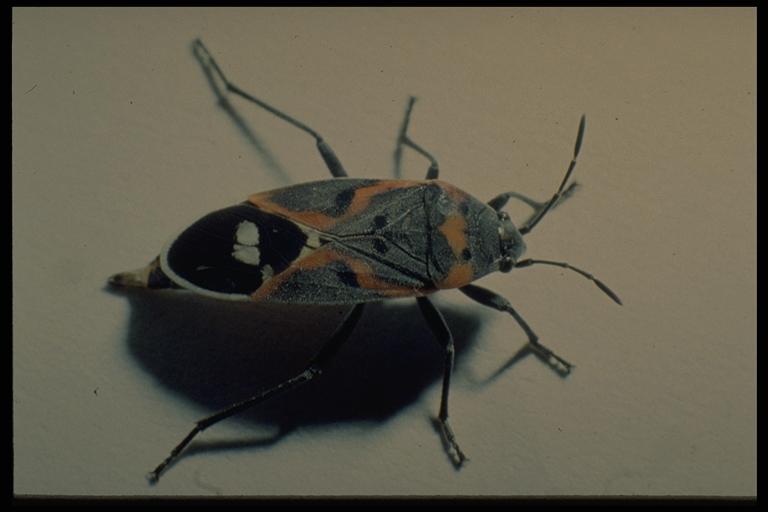
Chinch bugs, Blissus sp. (Hemiptera: Lygaeidae), nymphs and adults. Photo by Drees.
Common Name: Chinch bug
Scientific Name: Blissus sp.
Order: Hemiptera
Description: Adult chinch bugs are almost 3/16-inch long, have black bodies and fully developed wings that appear frosty-white except for distinctive triangular black patch-like markings at the middles of the outer margins. Adults appear as either long-winged or short-winged forms. Newly hatched nymphs appear orange red with a pale whitish band across their abdomens. As they molt through five growth stages (instars), nymphs gradually change color from red to orange to black and develop wing pads as they develop.
The common chinch bug, Blissus leucopterus leucopterus (Say) also occurs in Texas and has a wide range of host plants, including corn, rice, small grains, sorghum and bunch grasses and turf grasses. Nymphal and adult stages feed on all parts of host plants. In corn and sorghum fields, injury is most severe in early spring (March) when plants are young and drought stressed. Nymphs congregate and feed behind the sheaths of leaves. Appearance, damage and life history is very similar to that of the southern chinch bug. The false chinch bug, Nysius raphanus Howard (Heteroptera: Lygaeidae) and N. ericae (Schilling) are similar in appearance and habits to chinch bugs, but feed

Large milkweed bug, Oncopeltus fasciatus (Dallas) (Hemiptera: Lygaeidae). Photo by Drees.
primarily on the seed heads of sorghum and weed seeds. Other common lygaeids are the large milkweed bug, Oncopeltus fasciatus (Dallas) and species in the genus Lygaeus.
Life Cycle:Adults overwinter in protected places like weeds and grasses, becoming active in the spring. During mild winters and probably in southern Texas, all developmental stages may survive. Mated females lay eggs singly behind leaf sheaths or in the soil around host plants. Wingless nymphs hatch from eggs in about two weeks and develop through five stages for about 30 days before becoming adults. The entire life cycle can occur in about 6 weeks or longer, depending on temperature. Two to five or more generations can occur annually.
Habitat and Food Source(s), Damage: St. Augustine grass is the primary host of the southern chinch bug. Other host plants include Bermudagrass, bahiagrass, centipedegrass and zoysiagrass. Nymphs and adults use their sucking mouthparts to remove sap from the base (crown) and stolons of plants and inject a toxic substance that prevents the plant from transporting water.
In turfgrass areas, injury typically appears as yellow or dead drought-stressed or heat-stressed spots in the yard, most commonly in July and August. Infestations are usually initially localized because chinch bugs feed in

A lygaeid, Lygaeus sp. (Hemiptera: Lygaeidae). Photo by Jackman.
aggregates. Injured plants occur in spots or patches that enlarge as the population increases and spreads. When infested host plants die, high numbers of chinch bugs migrate by walking to neighboring lawns or turf areas in search of suitable host plants.
Chinch bugs can be collected from infested plants by flotation. A coffee can, with both ends removed can be forced into the soil through turfgrass thatch and filled with water. Most of the chinch bugs in the sampled area will float to the top. Chinch bugs can also be forced out of turfgrass thatch by sprinkling an infested area with a dilute liquid dishwashing soap solution (1 oz. per gallon of water to 2 square feet of sod) which is irritating to chinch bugs and other thatch dwelling arthropods.
Pest Status: Capable of injuring plants such as grasses, corn and sorghum; medically harmless.
For additional information, contact your local Texas A&M AgriLife Extension Service agent or search for other state Extension offices.
Literature: Carter et al. 1982; Hamman 1979; Olkowski et al. 1991; Randolph & Garner 1961; Reinert et al. 1995.